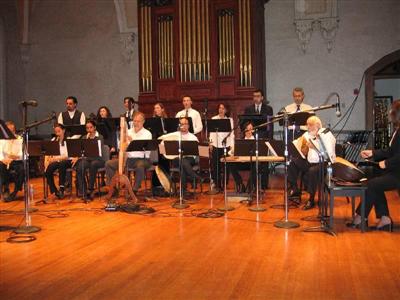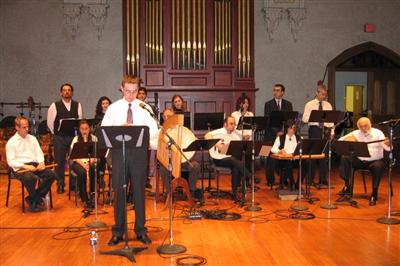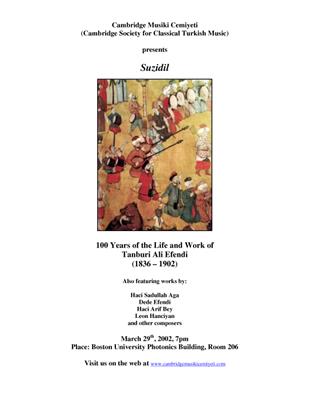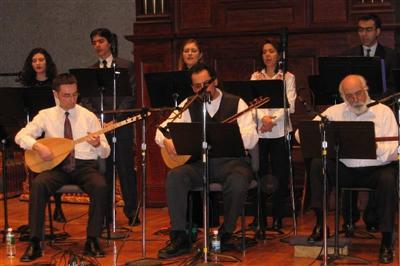I am a member of the local Turkish Music group Cambridge Musiki Cemiyeti (roughly transtlates to Cambridge Society for Classical Turkish Music). If you've been to a local Turkish music concert in Boston or Worcester, chances are you've seen the group. We perform once or twice a year.
The group's musical director is Feridun Ozgoren, who generously offers his time and service to anyone who is smart enough to benefit from his knowledge. Here are some photos and concert fliers from past concerts (each pic linked to the full size copy).

Concert in Holy Cross College Worcester MA.
Concert in Holy Cross College Worcester MA.

I had a solo performance in this concert. I humbly present an mp3 recording, if you are curious about what Turkish music sounds like. I'll remove this link if enough people complain :p.. It starts with a beautiful
müsterek taksim in makam Hisarbuselik, and then I sing
"Gönlüm Hevesi Zülf-i Siyehkâre Düsürdüm", a Hisarbuselik Yürük Semai composed by Zekâi Dede.

Poster for one of our concerts.
And the joy of making musical instruments...
As I already mentioned, our group director Feridun Ozgoren is a very generous artist. His main interest is the art of Turkish paper marbling (Ebru), but he is also a master luthier. He studied instrument making in Turkey, and he makes many instruments including tanbur, ud, kemence, ney, and various percussion instruments. With his guidance I built a Klasik Kemençe (pronounced kamancha, and not to be confused with Karadeniz Kemence). Here are some pictures that I've taken at different stages of the construction:
 |
 |
 |
 |
 |
 |
 |
 |
 |
From left to right:
1) After carving out the inside
2) Putting in the inlays,
3) Here is what the back looks like
4) Shellacking process
5) After shellack is put on. Beautiful artwork in the background by Nan Freeman.
6) Putting in the strings,
7-8) Back and front closeups after it's all done
9) In the hands of a player (not me).
I carved the body from a large slab of mahogany. The soundboard is sitka spruce, the keyboard is made ebony and the tuning pegs are made of rosewood. I used a combination of padauk and cherry for the bow. The hair of the bow is real horse hair , and the strings are made of cattle guts (imported from Europe). With the exception of the first string (which is a regular violin string), the instrument could easily get organic certification.
I completed my kemençe two years ago. It was a quite involving project. I spent several saturdays in the studio for almost a year, but the end result was really satisfying considering kemençe is one of my favorite instruments. Also seeing a big block of wood turn into a delicate instrument was a highly fulfilling experience, not to mention a therapeutic one.
My current project is building a tanbur. Although I got started on that, now research is taking more and more time as I get closer to actually graduation. Check back for updates ;-)
